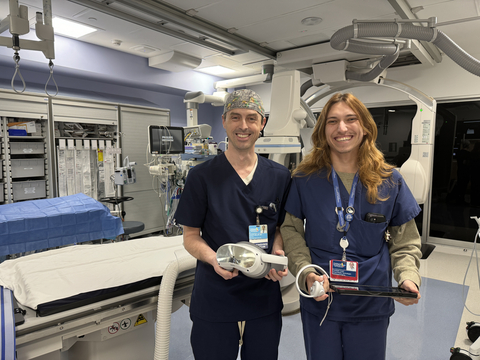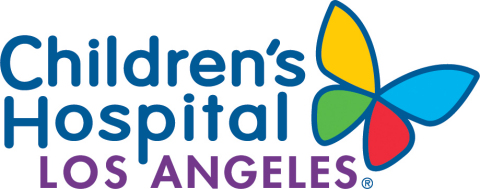ADDING CAPTION Children’s Hospital Los Angeles Uses Virtual Reality to Transform Minimally Invasive Procedures for Patients
ADDING CAPTION Children’s Hospital Los Angeles Uses Virtual Reality to Transform Minimally Invasive Procedures for Patients
LOS ANGELES--(BUSINESS WIRE)--For the press release dated December 16, 2024, add caption: Left to Right: Joseph Miller, MD, MS, Director of Interventional Radiology, and Phoenix Hunt, VR Technologist. (Photo: Business Wire)
The release reads:
CHILDREN’S HOSPITAL LOS ANGELES USES VIRTUAL REALITY TO TRANSFORM MINIMALLY INVASIVE PROCEDURES FOR PATIENTS
If your heart rate increases each time you hear the word “injection,” you’re not alone. Every 1 in 4 adults has a fear of needles—a fear that most attribute to an experience they had when they were children.
For kids who visit the hospital frequently, anxiety around even routine procedures might interfere with each visit and even lead to long-term trauma.
Children’s Hospital Los Angeles’ Interventional Radiology team—one of the most universally visited specialties at the hospital—is working to minimize negative medical experiences using virtual reality (VR) technology. In August, they hired Phoenix Hunt, CHLA’s first embedded hospital VR technologist, to guide and support patients through their procedures using specially designed, procedure-specific VR games.
“In most health care contexts, VR has been used to support patients as a relaxation tool,” explains Joseph Miller, MD, MS, Director of Interventional Radiology. “We’re applying these same types of technologies to pediatrics in a novel way to minimize anxiety, pain, and discomfort and even reduce anesthesia use.”
Interventional radiology: An ideal VR use case
Interventional radiology provides minimally invasive care in a variety of ways. The specialty uses medical imaging such as X-rays, CT scans, ultrasounds, and MRIs to insert small devices—like catheters, IVs, or wires—into the body, or to perform biopsies.
Most interventional radiology procedures only take a few minutes, but the prep time and setup are much more complex.
“A patient who just needs something to ease the anxiety and discomfort of the procedure ends up having to go without eating all night so we can administer anesthesia in the morning,” explains Dr. Miller.
As the medications leave the patient’s system, it can take several hours to fully recover. “That’s a lot logistically for the patient—and for their family and care team—for what is ultimately a five-minute procedure,” he adds. “Our goal is to reduce that footprint for everybody.”
VR as a therapeutic tool
“When you put a headset on somebody in a health care setting, it can transform their mind and immerse them in a completely different environment,” explains Hunt. “It helps detach their anxieties from what they're feeling and experiencing in the real world.”
This phenomenon has been studied extensively by CHLA’s Biobehavioral Pain Lab, led by Jeffrey Gold, PhD, whose research seeks to enhance the standard of care for anxious patients beyond administering medication to ease fear.
“VR can help dampen the brain’s pain receptors,” Hunt says. “Your body is so distracted with other stimuli that it kind of forgets to feel that anxiety or pain that you’d be noticing previously.”
A nationwide search
“What we were missing was not so much the technology itself,” says Dr. Miller, reflecting on the early days of conceiving the program. “It was the person to help apply the technology in an individualized fashion.”
That’s where Hunt came in.
Hunt studied virtual-reality game design at Savannah College of Art and Design and was drawn to VR applications in health care. “I was perfectly good at designing video games, but I realized I wanted to work in the clinical setting as soon as I started connecting with patients,” he explains.
“The more positive experiences I helped foster, the more I thought, ‘This is what I want to do for the rest of my life.’”
As Dr. Miller and the team finalized their vision for the VR technologist position, it became clear that CHLA would effectively create the blueprint for future U.S. hospitals. “We’ve yet to encounter another hospital using VR to get patients through procedures with an embedded VR technologist,” Dr. Miller says.
The role is made possible by the financial support of the nonprofit Child’s Play, which assists hospitals across the country in a variety of technology adoption initiatives.
It just so happened that the job posting coincided perfectly with Hunt’s post-grad career search. He joined the team in August, and they treated their first patient using VR a month later.
Early successes
Keira, a high school junior, came to Interventional Radiology in September feeling apprehensive and anxious.
Doctors had discovered a mass in her thyroid in July. After several scans and a biopsy under “twilight” sedation at another hospital, the mass was determined to be highly indicative of cancer. That’s when Keira’s family was referred to CHLA for care, where her care team confirmed that she would need surgery to remove her thyroid and several lymph nodes. First, she’d need more scans and a second biopsy to determine the extent of the surgery.
Keira recalls how nervous she felt heading into a second biopsy. Throughout her life, the thought of any medical procedure terrified her. Until the first biopsy, she had never had sedation, and, although it had gone well, she was concerned about having it again.
On the day of her biopsy, Keira’s care team presented her with a spectrum of options, from full sedation to VR only. At first, she was skeptical. Would she really be able to remain calm, still, and allow the team to complete the procedure without any sedation?
In pre-op, Hunt showed Keira the games and the “passthrough” setting, where cameras on the headset’s exterior would allow her to see into the room. “I was actually starting to consider that VR could be a real possibility,” she recalls.
With Hunt’s help, Keira played VR games and talked with her care team throughout the 30-minute procedure with no sedation, and only local anesthetic applied to the procedure site.
“My eyes were somewhere else...but the team also kind of kept me aware of what was happening so I would never get startled,” Keira reflects. “The combination of people talking to me and the VR were really helpful at making it feel like a safe space.”
The process
Hunt’s role is evolving as the program evolves and expands, he explains, but most procedures happen as follows:
“I first spend some time with the patient to explain the process and get a feel for what game they may want to play,” he says. CHLA’s VR headsets are equipped with several programs depending on the age of the patient, their level of anxiety, and the type of procedure (some games require the patient to use only their eyes and a trigger button while keeping their head, arms, and torso still, while others enable the use of one arm or both).
Next, Hunt invites the patient to test-drive the game so they know what to expect. He adds that he personally tests out every game before offering it to a patient to minimize any day-of surprises.
Once the patient arrives at the procedure site and is outfitted with a VR headset, Hunt collaborates with the medical team to monitor their heart rate, anxiety level, and pain levels before, during, and after the procedure.
“At the end, I ask them if they’d want to do this again, and if they preferred it to anesthesia,” says Hunt. “So far, across the board, everyone has had overwhelmingly positive feedback.”
Scaling VR at CHLA
“Many hospitals have VR headsets that just sit on the shelf because no one has any idea how to apply them,” says Dr. Miller. “Our missing piece at CHLA was Phoenix.”
Currently, Hunt is the only person at CHLA implementing VR during procedures—but the team has big plans to grow the program. “We’re exploring all of the ways VR can be used across departments and patient populations,” Dr. Miller shares. “It's not just for us, or even just for our patients—creating additional resources to reduce the work burden on health care team members is a huge deal.”
“We’re trying to turn this program into a living, breathing resource for the entire hospital, where eventually care teams can request a VR technologist’s assistance as needed,” Hunt adds.
Future focused
Dr. Miller and Hunt not only have an ambitious vision for VR technology within CHLA, but also in hospitals across the world. “When I was in school and told people I wanted to explore VR applications in health care, almost everybody told me that it wouldn’t happen for at least another 10 years,” Hunt reflects. “But our work here proves it’s coming a lot faster than people think.”
“I’m thrilled that CHLA is at the forefront of this movement,” adds Dr. Miller. “I look forward to spending a lot of time perfecting our operations to make our patients' lives better—and then, hopefully, helping other hospitals do the same.”
Learn more about interventional radiology at Children’s Hospital Los Angeles.
About Children’s Hospital Los Angeles
Founded in 1901, Children’s Hospital Los Angeles is at the forefront of pediatric medicine and is the largest provider of hospital care for children in California. Children’s Hospital is home to renowned experts who work together across disciplines to deliver inclusive and compassionate care, and drive advances that set pediatric standards across the nation and around the globe. Children’s Hospital Los Angeles provides a level of care to its diverse population of children that is among the best in the world. The hospital is consistently ranked in the top 10 in the nation on U.S. News & World Report’s Honor Roll of Best Children’s Hospitals. CHLA is the top-ranked children’s hospital in California and the Pacific U.S. region for 2024-25. Children’s Hospital Los Angeles embraces its mission to create hope and build healthier futures. Children’s Hospital Los Angeles is among the top 10 children’s hospitals for National Institutes of Health funding. The Saban Research Institute of Children's Hospital Los Angeles supports the full continuum of research, allowing physicians and scientists to translate discoveries into treatments and bring answers to families faster. The pediatric academic medical center also is home to one of the largest training programs for pediatricians in the United States. And the hospital’s commitment to building strong communities is evident in CHLA’s efforts to fight food insecurity, enhance health education and literacy, and introduce more people to careers in health care. To learn more, follow CHLA on Facebook, Instagram, LinkedIn, YouTube and X, formerly known as Twitter, and visit CHLA.org/blog.
Contacts
Contact us
media@chla.usc.edu

